Business Research Project: Globalisation, Data Analysis & Ethics
VerifiedAdded on 2020/11/12
|24
|5046
|80
Project
AI Summary
This research project explores the impact of globalisation on businesses, employing both primary and secondary research methods. It details the use of questionnaires for primary data collection, including questions on globalisation awareness, benefits, and challenges. Secondary data is incorporated through literature review. The project utilizes thematic analysis to interpret the collected data, presenting findings on the benefits of globalisation, investment strategies, and ethical considerations. The project also highlights the importance of ethical considerations in research, ensuring confidentiality of respondent information. The analysis includes frequency tables and interpretations of key themes, offering insights into the impact of globalisation on business operations and strategies. The project concludes with an evaluation of the research methods and suggestions for alternative approaches.
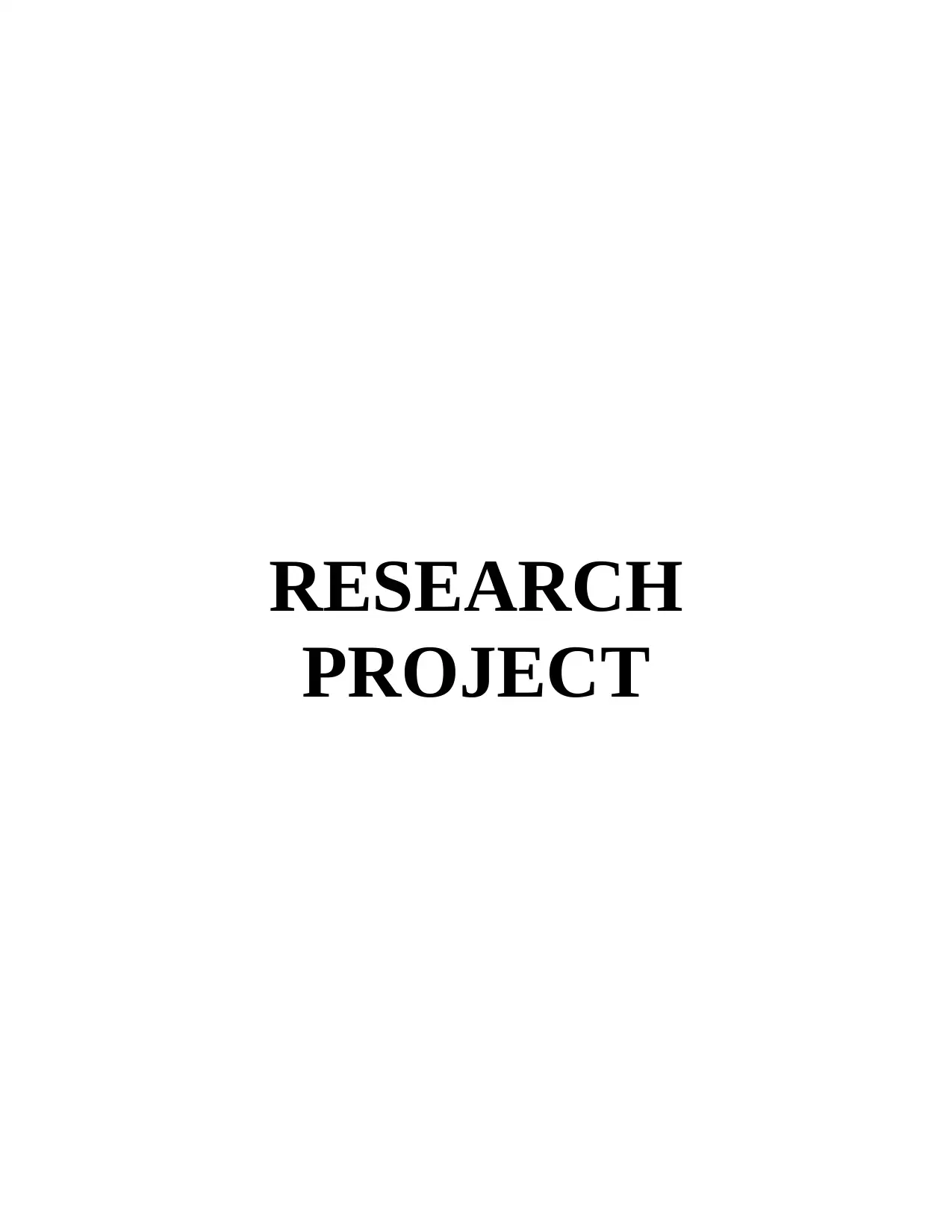
RESEARCH
PROJECT
PROJECT
Paraphrase This Document
Need a fresh take? Get an instant paraphrase of this document with our AI Paraphraser

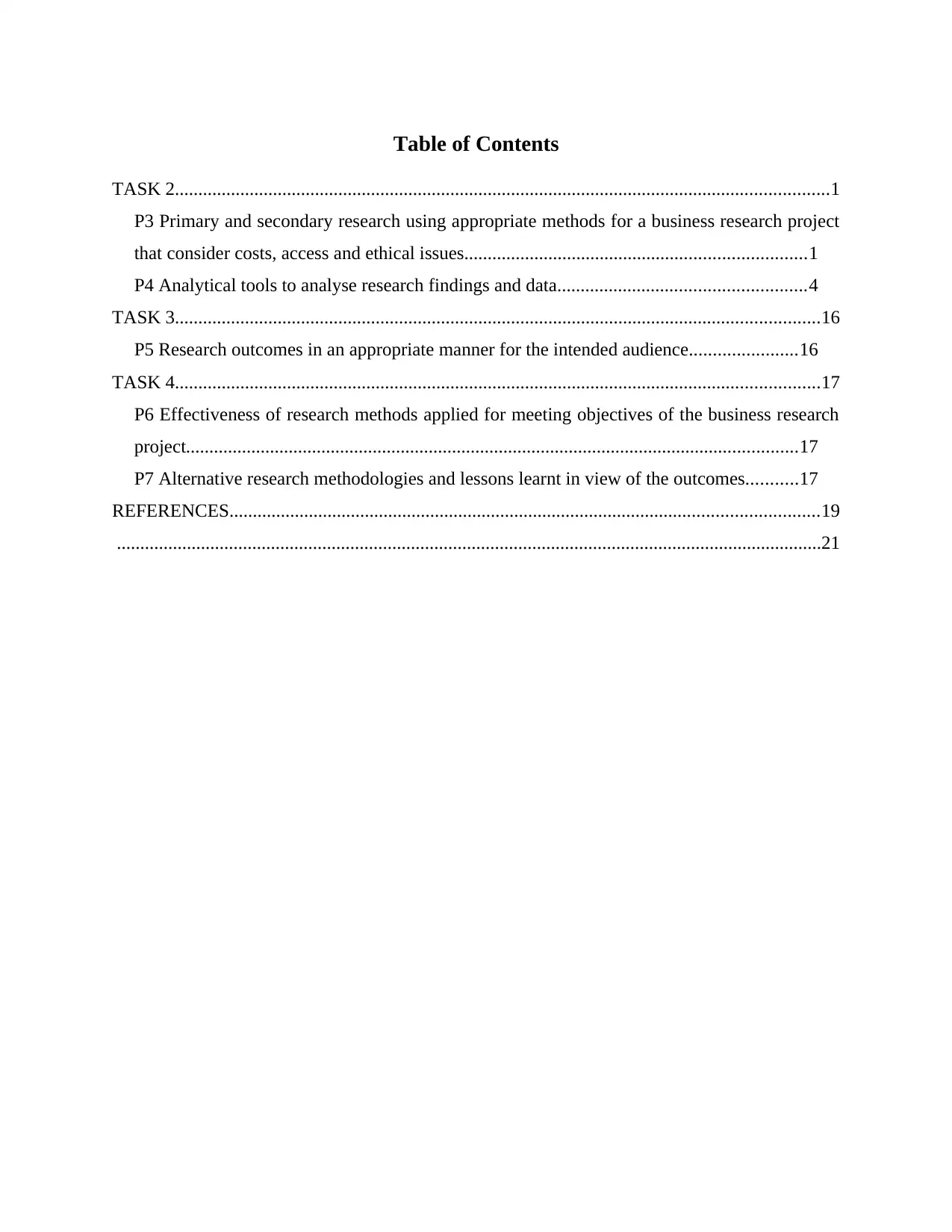
Table of Contents
TASK 2............................................................................................................................................1
P3 Primary and secondary research using appropriate methods for a business research project
that consider costs, access and ethical issues.........................................................................1
P4 Analytical tools to analyse research findings and data.....................................................4
TASK 3..........................................................................................................................................16
P5 Research outcomes in an appropriate manner for the intended audience.......................16
TASK 4..........................................................................................................................................17
P6 Effectiveness of research methods applied for meeting objectives of the business research
project...................................................................................................................................17
P7 Alternative research methodologies and lessons learnt in view of the outcomes...........17
REFERENCES..............................................................................................................................19
.......................................................................................................................................................21
TASK 2............................................................................................................................................1
P3 Primary and secondary research using appropriate methods for a business research project
that consider costs, access and ethical issues.........................................................................1
P4 Analytical tools to analyse research findings and data.....................................................4
TASK 3..........................................................................................................................................16
P5 Research outcomes in an appropriate manner for the intended audience.......................16
TASK 4..........................................................................................................................................17
P6 Effectiveness of research methods applied for meeting objectives of the business research
project...................................................................................................................................17
P7 Alternative research methodologies and lessons learnt in view of the outcomes...........17
REFERENCES..............................................................................................................................19
.......................................................................................................................................................21
⊘ This is a preview!⊘
Do you want full access?
Subscribe today to unlock all pages.

Trusted by 1+ million students worldwide
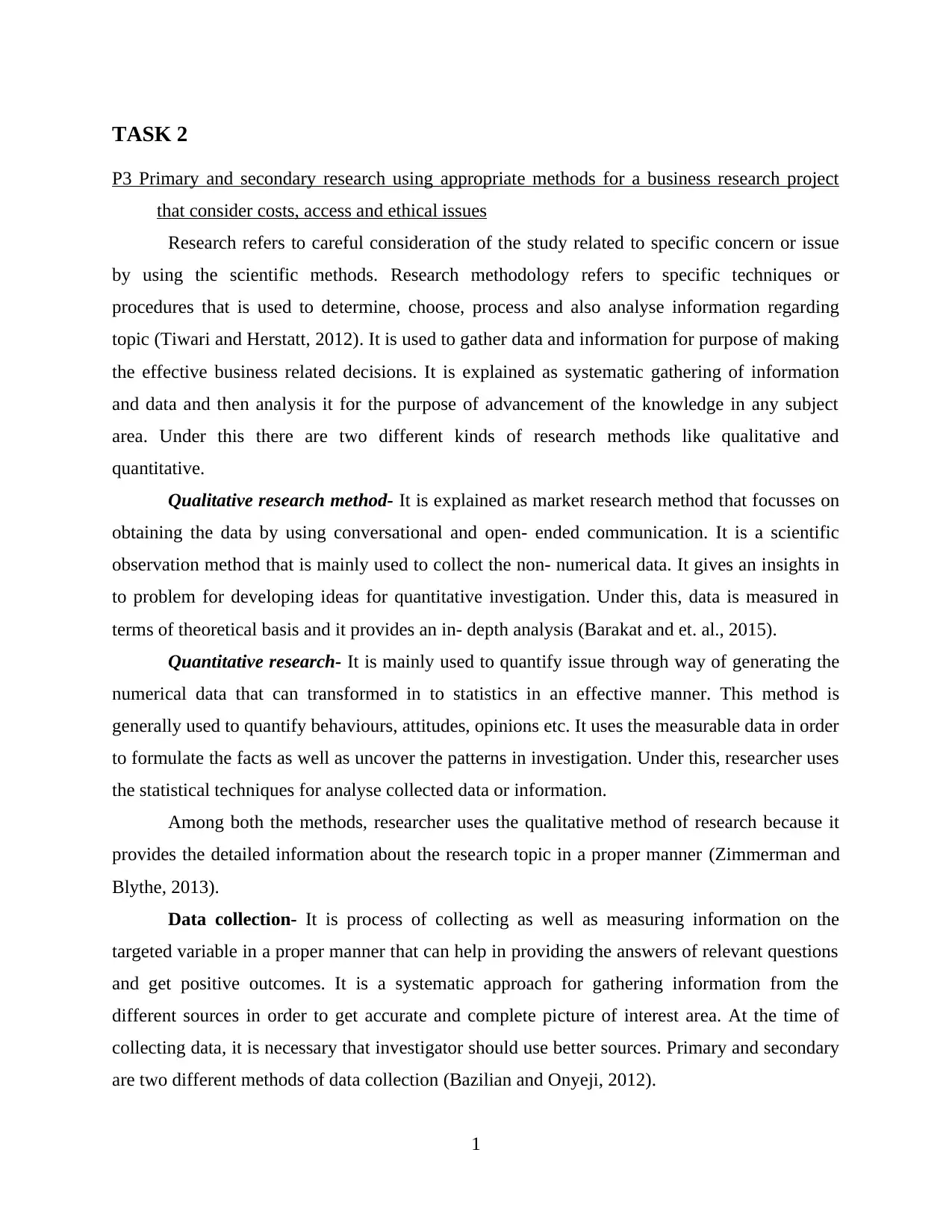
TASK 2
P3 Primary and secondary research using appropriate methods for a business research project
that consider costs, access and ethical issues
Research refers to careful consideration of the study related to specific concern or issue
by using the scientific methods. Research methodology refers to specific techniques or
procedures that is used to determine, choose, process and also analyse information regarding
topic (Tiwari and Herstatt, 2012). It is used to gather data and information for purpose of making
the effective business related decisions. It is explained as systematic gathering of information
and data and then analysis it for the purpose of advancement of the knowledge in any subject
area. Under this there are two different kinds of research methods like qualitative and
quantitative.
Qualitative research method- It is explained as market research method that focusses on
obtaining the data by using conversational and open- ended communication. It is a scientific
observation method that is mainly used to collect the non- numerical data. It gives an insights in
to problem for developing ideas for quantitative investigation. Under this, data is measured in
terms of theoretical basis and it provides an in- depth analysis (Barakat and et. al., 2015).
Quantitative research- It is mainly used to quantify issue through way of generating the
numerical data that can transformed in to statistics in an effective manner. This method is
generally used to quantify behaviours, attitudes, opinions etc. It uses the measurable data in order
to formulate the facts as well as uncover the patterns in investigation. Under this, researcher uses
the statistical techniques for analyse collected data or information.
Among both the methods, researcher uses the qualitative method of research because it
provides the detailed information about the research topic in a proper manner (Zimmerman and
Blythe, 2013).
Data collection- It is process of collecting as well as measuring information on the
targeted variable in a proper manner that can help in providing the answers of relevant questions
and get positive outcomes. It is a systematic approach for gathering information from the
different sources in order to get accurate and complete picture of interest area. At the time of
collecting data, it is necessary that investigator should use better sources. Primary and secondary
are two different methods of data collection (Bazilian and Onyeji, 2012).
1
P3 Primary and secondary research using appropriate methods for a business research project
that consider costs, access and ethical issues
Research refers to careful consideration of the study related to specific concern or issue
by using the scientific methods. Research methodology refers to specific techniques or
procedures that is used to determine, choose, process and also analyse information regarding
topic (Tiwari and Herstatt, 2012). It is used to gather data and information for purpose of making
the effective business related decisions. It is explained as systematic gathering of information
and data and then analysis it for the purpose of advancement of the knowledge in any subject
area. Under this there are two different kinds of research methods like qualitative and
quantitative.
Qualitative research method- It is explained as market research method that focusses on
obtaining the data by using conversational and open- ended communication. It is a scientific
observation method that is mainly used to collect the non- numerical data. It gives an insights in
to problem for developing ideas for quantitative investigation. Under this, data is measured in
terms of theoretical basis and it provides an in- depth analysis (Barakat and et. al., 2015).
Quantitative research- It is mainly used to quantify issue through way of generating the
numerical data that can transformed in to statistics in an effective manner. This method is
generally used to quantify behaviours, attitudes, opinions etc. It uses the measurable data in order
to formulate the facts as well as uncover the patterns in investigation. Under this, researcher uses
the statistical techniques for analyse collected data or information.
Among both the methods, researcher uses the qualitative method of research because it
provides the detailed information about the research topic in a proper manner (Zimmerman and
Blythe, 2013).
Data collection- It is process of collecting as well as measuring information on the
targeted variable in a proper manner that can help in providing the answers of relevant questions
and get positive outcomes. It is a systematic approach for gathering information from the
different sources in order to get accurate and complete picture of interest area. At the time of
collecting data, it is necessary that investigator should use better sources. Primary and secondary
are two different methods of data collection (Bazilian and Onyeji, 2012).
1
Paraphrase This Document
Need a fresh take? Get an instant paraphrase of this document with our AI Paraphraser
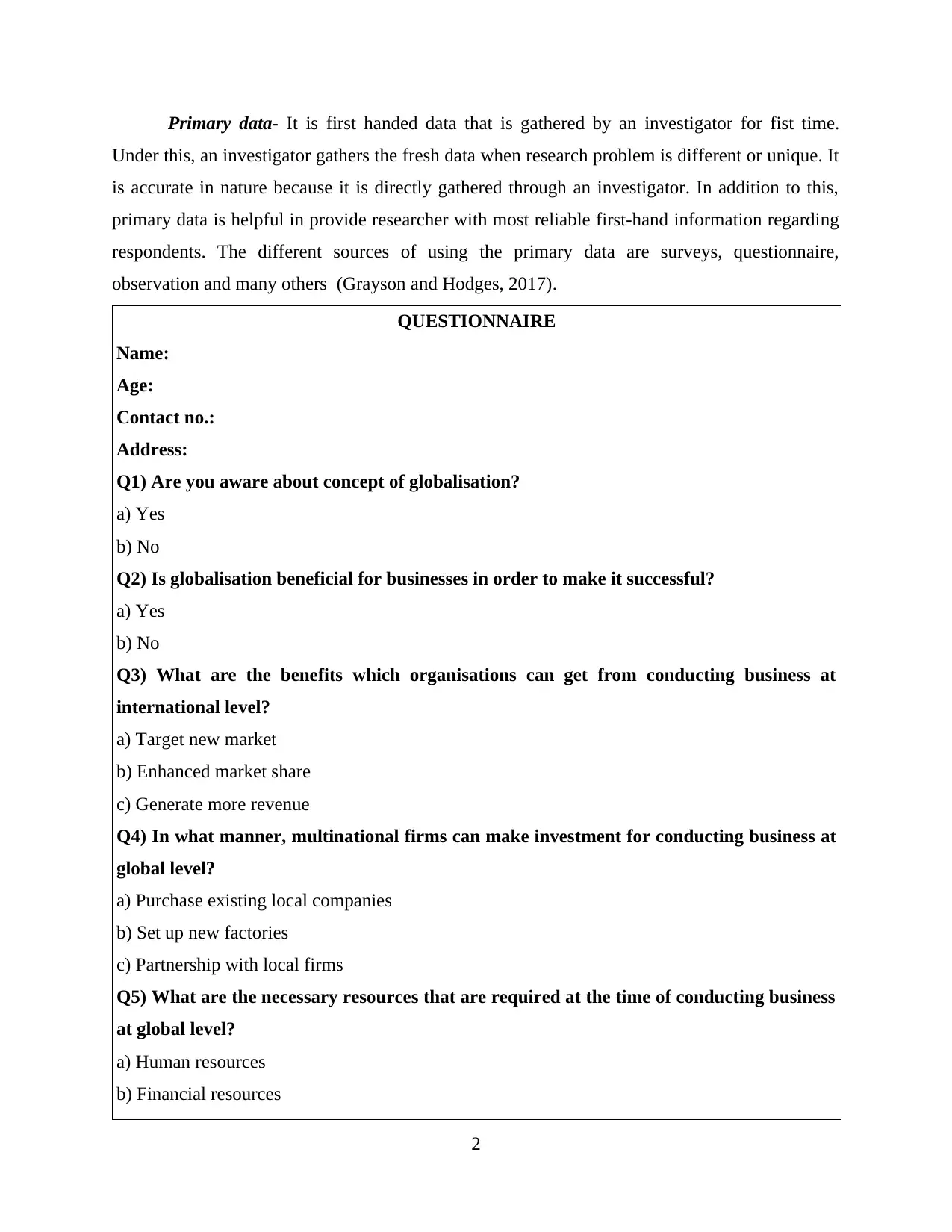
Primary data- It is first handed data that is gathered by an investigator for fist time.
Under this, an investigator gathers the fresh data when research problem is different or unique. It
is accurate in nature because it is directly gathered through an investigator. In addition to this,
primary data is helpful in provide researcher with most reliable first-hand information regarding
respondents. The different sources of using the primary data are surveys, questionnaire,
observation and many others (Grayson and Hodges, 2017).
QUESTIONNAIRE
Name:
Age:
Contact no.:
Address:
Q1) Are you aware about concept of globalisation?
a) Yes
b) No
Q2) Is globalisation beneficial for businesses in order to make it successful?
a) Yes
b) No
Q3) What are the benefits which organisations can get from conducting business at
international level?
a) Target new market
b) Enhanced market share
c) Generate more revenue
Q4) In what manner, multinational firms can make investment for conducting business at
global level?
a) Purchase existing local companies
b) Set up new factories
c) Partnership with local firms
Q5) What are the necessary resources that are required at the time of conducting business
at global level?
a) Human resources
b) Financial resources
2
Under this, an investigator gathers the fresh data when research problem is different or unique. It
is accurate in nature because it is directly gathered through an investigator. In addition to this,
primary data is helpful in provide researcher with most reliable first-hand information regarding
respondents. The different sources of using the primary data are surveys, questionnaire,
observation and many others (Grayson and Hodges, 2017).
QUESTIONNAIRE
Name:
Age:
Contact no.:
Address:
Q1) Are you aware about concept of globalisation?
a) Yes
b) No
Q2) Is globalisation beneficial for businesses in order to make it successful?
a) Yes
b) No
Q3) What are the benefits which organisations can get from conducting business at
international level?
a) Target new market
b) Enhanced market share
c) Generate more revenue
Q4) In what manner, multinational firms can make investment for conducting business at
global level?
a) Purchase existing local companies
b) Set up new factories
c) Partnership with local firms
Q5) What are the necessary resources that are required at the time of conducting business
at global level?
a) Human resources
b) Financial resources
2
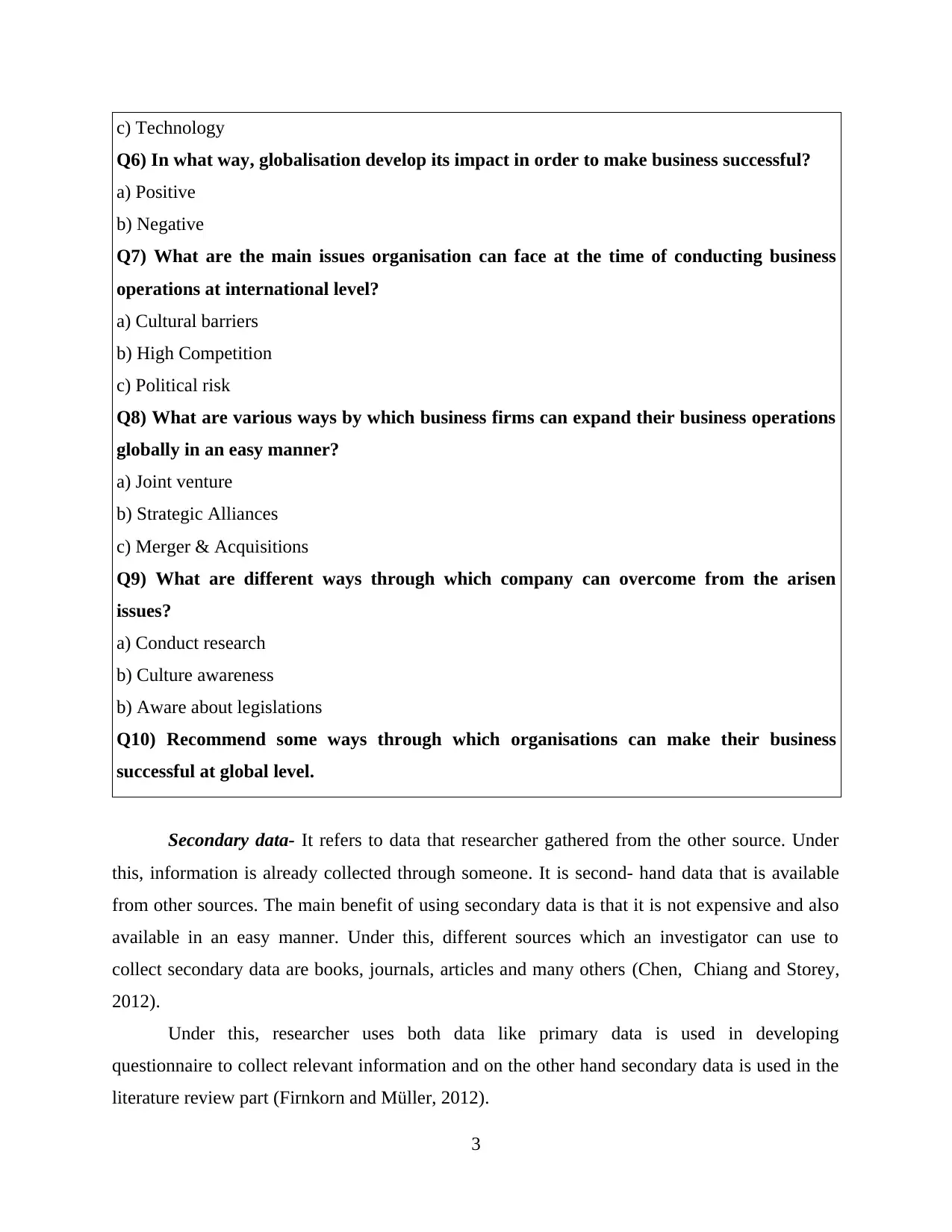
c) Technology
Q6) In what way, globalisation develop its impact in order to make business successful?
a) Positive
b) Negative
Q7) What are the main issues organisation can face at the time of conducting business
operations at international level?
a) Cultural barriers
b) High Competition
c) Political risk
Q8) What are various ways by which business firms can expand their business operations
globally in an easy manner?
a) Joint venture
b) Strategic Alliances
c) Merger & Acquisitions
Q9) What are different ways through which company can overcome from the arisen
issues?
a) Conduct research
b) Culture awareness
b) Aware about legislations
Q10) Recommend some ways through which organisations can make their business
successful at global level.
Secondary data- It refers to data that researcher gathered from the other source. Under
this, information is already collected through someone. It is second- hand data that is available
from other sources. The main benefit of using secondary data is that it is not expensive and also
available in an easy manner. Under this, different sources which an investigator can use to
collect secondary data are books, journals, articles and many others (Chen, Chiang and Storey,
2012).
Under this, researcher uses both data like primary data is used in developing
questionnaire to collect relevant information and on the other hand secondary data is used in the
literature review part (Firnkorn and Müller, 2012).
3
Q6) In what way, globalisation develop its impact in order to make business successful?
a) Positive
b) Negative
Q7) What are the main issues organisation can face at the time of conducting business
operations at international level?
a) Cultural barriers
b) High Competition
c) Political risk
Q8) What are various ways by which business firms can expand their business operations
globally in an easy manner?
a) Joint venture
b) Strategic Alliances
c) Merger & Acquisitions
Q9) What are different ways through which company can overcome from the arisen
issues?
a) Conduct research
b) Culture awareness
b) Aware about legislations
Q10) Recommend some ways through which organisations can make their business
successful at global level.
Secondary data- It refers to data that researcher gathered from the other source. Under
this, information is already collected through someone. It is second- hand data that is available
from other sources. The main benefit of using secondary data is that it is not expensive and also
available in an easy manner. Under this, different sources which an investigator can use to
collect secondary data are books, journals, articles and many others (Chen, Chiang and Storey,
2012).
Under this, researcher uses both data like primary data is used in developing
questionnaire to collect relevant information and on the other hand secondary data is used in the
literature review part (Firnkorn and Müller, 2012).
3
⊘ This is a preview!⊘
Do you want full access?
Subscribe today to unlock all pages.

Trusted by 1+ million students worldwide
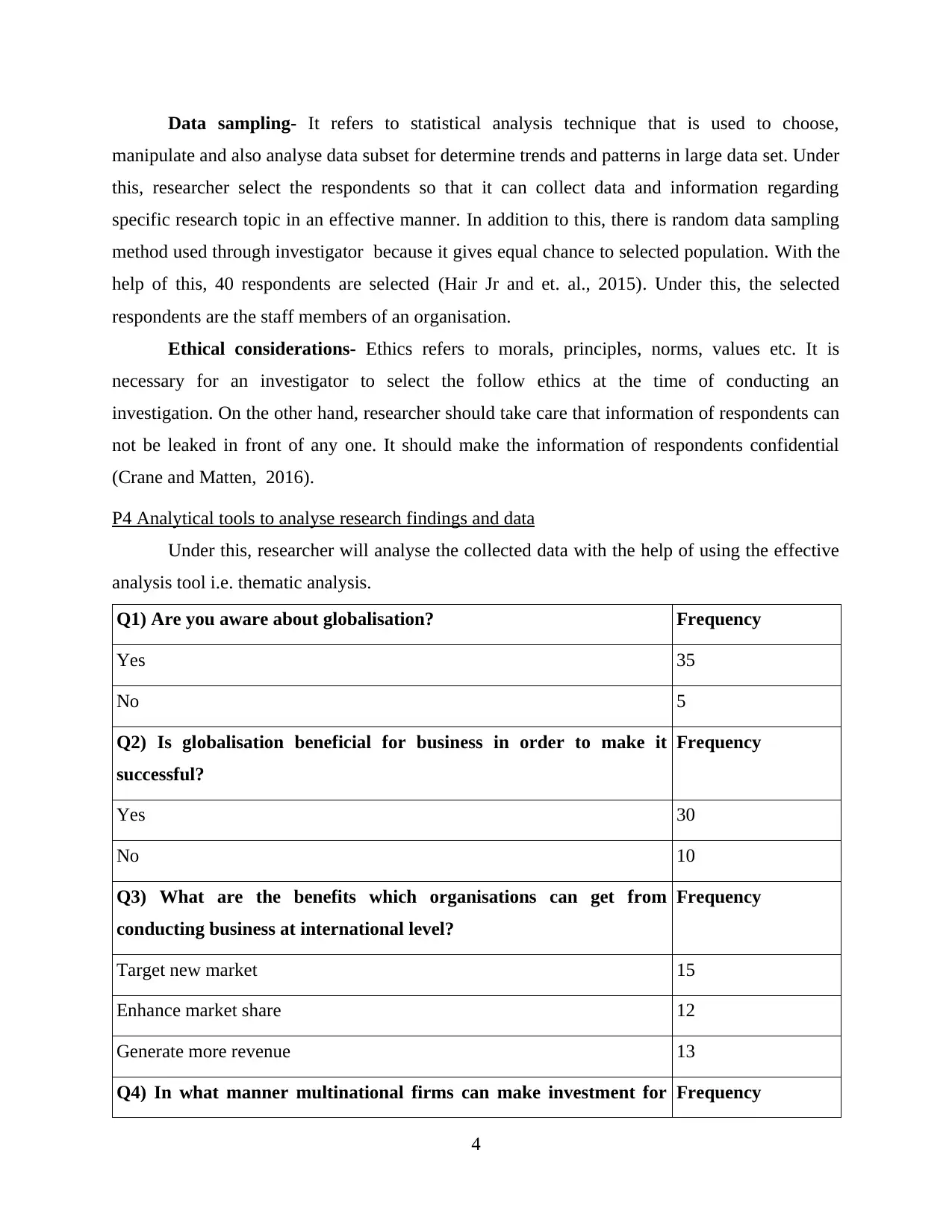
Data sampling- It refers to statistical analysis technique that is used to choose,
manipulate and also analyse data subset for determine trends and patterns in large data set. Under
this, researcher select the respondents so that it can collect data and information regarding
specific research topic in an effective manner. In addition to this, there is random data sampling
method used through investigator because it gives equal chance to selected population. With the
help of this, 40 respondents are selected (Hair Jr and et. al., 2015). Under this, the selected
respondents are the staff members of an organisation.
Ethical considerations- Ethics refers to morals, principles, norms, values etc. It is
necessary for an investigator to select the follow ethics at the time of conducting an
investigation. On the other hand, researcher should take care that information of respondents can
not be leaked in front of any one. It should make the information of respondents confidential
(Crane and Matten, 2016).
P4 Analytical tools to analyse research findings and data
Under this, researcher will analyse the collected data with the help of using the effective
analysis tool i.e. thematic analysis.
Q1) Are you aware about globalisation? Frequency
Yes 35
No 5
Q2) Is globalisation beneficial for business in order to make it
successful?
Frequency
Yes 30
No 10
Q3) What are the benefits which organisations can get from
conducting business at international level?
Frequency
Target new market 15
Enhance market share 12
Generate more revenue 13
Q4) In what manner multinational firms can make investment for Frequency
4
manipulate and also analyse data subset for determine trends and patterns in large data set. Under
this, researcher select the respondents so that it can collect data and information regarding
specific research topic in an effective manner. In addition to this, there is random data sampling
method used through investigator because it gives equal chance to selected population. With the
help of this, 40 respondents are selected (Hair Jr and et. al., 2015). Under this, the selected
respondents are the staff members of an organisation.
Ethical considerations- Ethics refers to morals, principles, norms, values etc. It is
necessary for an investigator to select the follow ethics at the time of conducting an
investigation. On the other hand, researcher should take care that information of respondents can
not be leaked in front of any one. It should make the information of respondents confidential
(Crane and Matten, 2016).
P4 Analytical tools to analyse research findings and data
Under this, researcher will analyse the collected data with the help of using the effective
analysis tool i.e. thematic analysis.
Q1) Are you aware about globalisation? Frequency
Yes 35
No 5
Q2) Is globalisation beneficial for business in order to make it
successful?
Frequency
Yes 30
No 10
Q3) What are the benefits which organisations can get from
conducting business at international level?
Frequency
Target new market 15
Enhance market share 12
Generate more revenue 13
Q4) In what manner multinational firms can make investment for Frequency
4
Paraphrase This Document
Need a fresh take? Get an instant paraphrase of this document with our AI Paraphraser
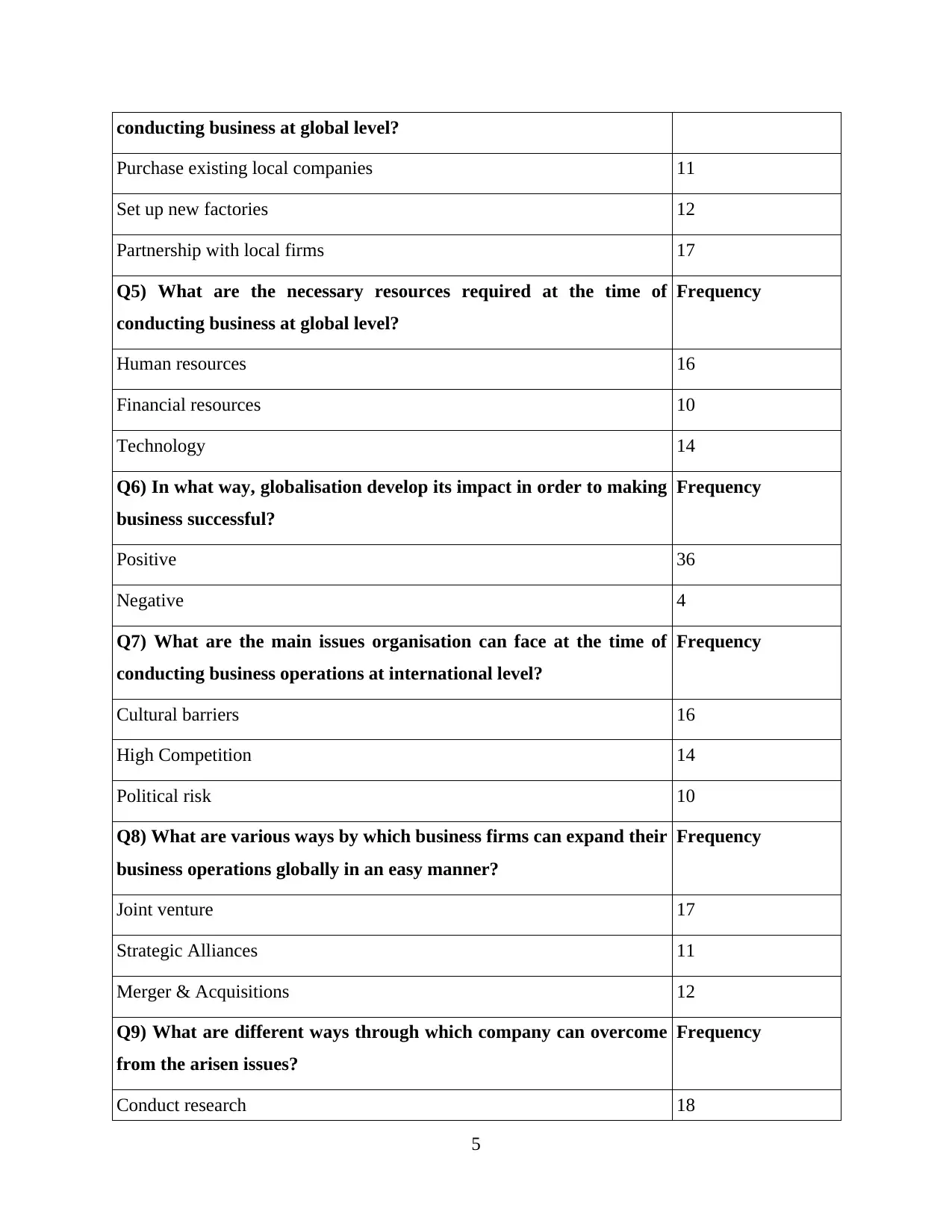
conducting business at global level?
Purchase existing local companies 11
Set up new factories 12
Partnership with local firms 17
Q5) What are the necessary resources required at the time of
conducting business at global level?
Frequency
Human resources 16
Financial resources 10
Technology 14
Q6) In what way, globalisation develop its impact in order to making
business successful?
Frequency
Positive 36
Negative 4
Q7) What are the main issues organisation can face at the time of
conducting business operations at international level?
Frequency
Cultural barriers 16
High Competition 14
Political risk 10
Q8) What are various ways by which business firms can expand their
business operations globally in an easy manner?
Frequency
Joint venture 17
Strategic Alliances 11
Merger & Acquisitions 12
Q9) What are different ways through which company can overcome
from the arisen issues?
Frequency
Conduct research 18
5
Purchase existing local companies 11
Set up new factories 12
Partnership with local firms 17
Q5) What are the necessary resources required at the time of
conducting business at global level?
Frequency
Human resources 16
Financial resources 10
Technology 14
Q6) In what way, globalisation develop its impact in order to making
business successful?
Frequency
Positive 36
Negative 4
Q7) What are the main issues organisation can face at the time of
conducting business operations at international level?
Frequency
Cultural barriers 16
High Competition 14
Political risk 10
Q8) What are various ways by which business firms can expand their
business operations globally in an easy manner?
Frequency
Joint venture 17
Strategic Alliances 11
Merger & Acquisitions 12
Q9) What are different ways through which company can overcome
from the arisen issues?
Frequency
Conduct research 18
5
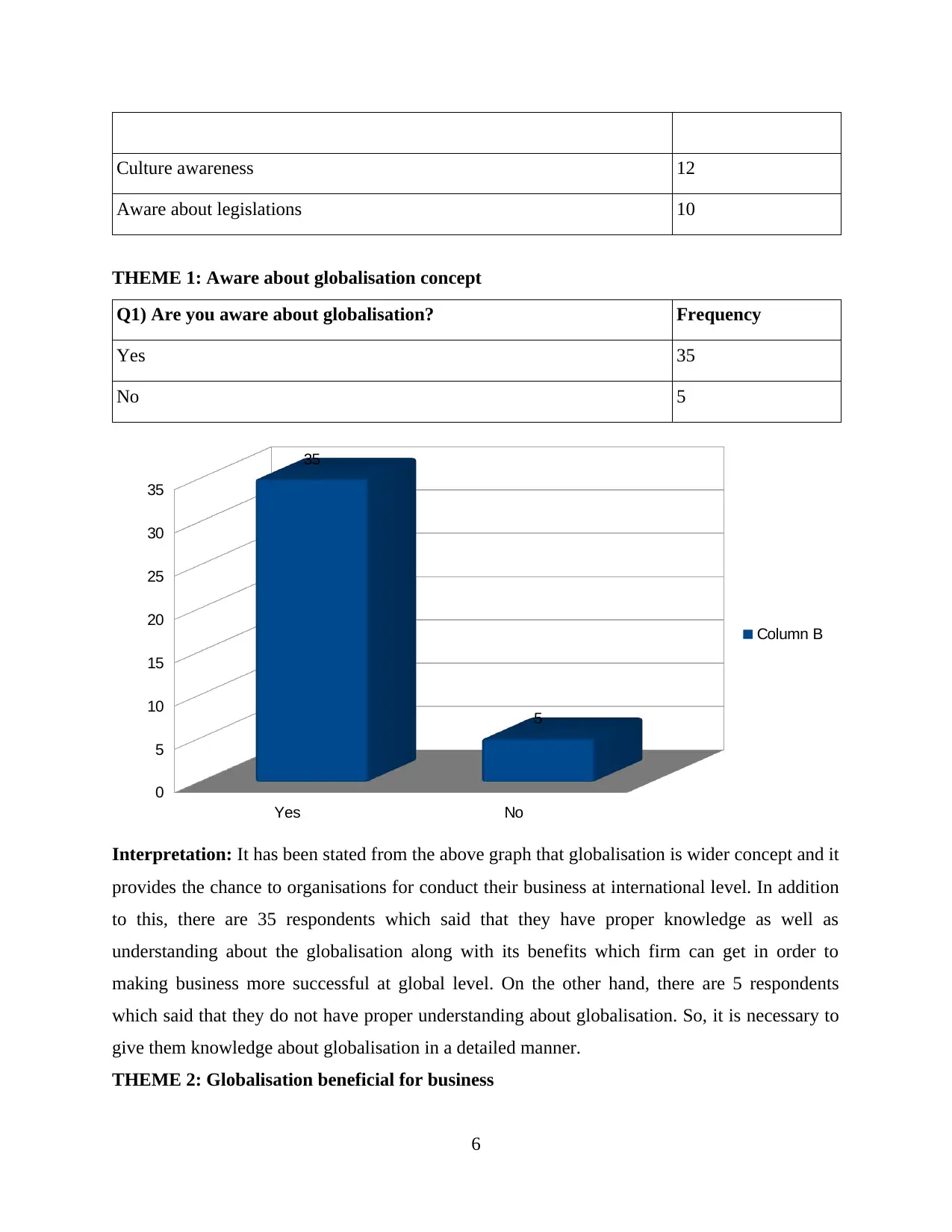
Culture awareness 12
Aware about legislations 10
THEME 1: Aware about globalisation concept
Q1) Are you aware about globalisation? Frequency
Yes 35
No 5
Interpretation: It has been stated from the above graph that globalisation is wider concept and it
provides the chance to organisations for conduct their business at international level. In addition
to this, there are 35 respondents which said that they have proper knowledge as well as
understanding about the globalisation along with its benefits which firm can get in order to
making business more successful at global level. On the other hand, there are 5 respondents
which said that they do not have proper understanding about globalisation. So, it is necessary to
give them knowledge about globalisation in a detailed manner.
THEME 2: Globalisation beneficial for business
6
Yes No
0
5
10
15
20
25
30
35
35
5
Column B
Aware about legislations 10
THEME 1: Aware about globalisation concept
Q1) Are you aware about globalisation? Frequency
Yes 35
No 5
Interpretation: It has been stated from the above graph that globalisation is wider concept and it
provides the chance to organisations for conduct their business at international level. In addition
to this, there are 35 respondents which said that they have proper knowledge as well as
understanding about the globalisation along with its benefits which firm can get in order to
making business more successful at global level. On the other hand, there are 5 respondents
which said that they do not have proper understanding about globalisation. So, it is necessary to
give them knowledge about globalisation in a detailed manner.
THEME 2: Globalisation beneficial for business
6
Yes No
0
5
10
15
20
25
30
35
35
5
Column B
⊘ This is a preview!⊘
Do you want full access?
Subscribe today to unlock all pages.

Trusted by 1+ million students worldwide
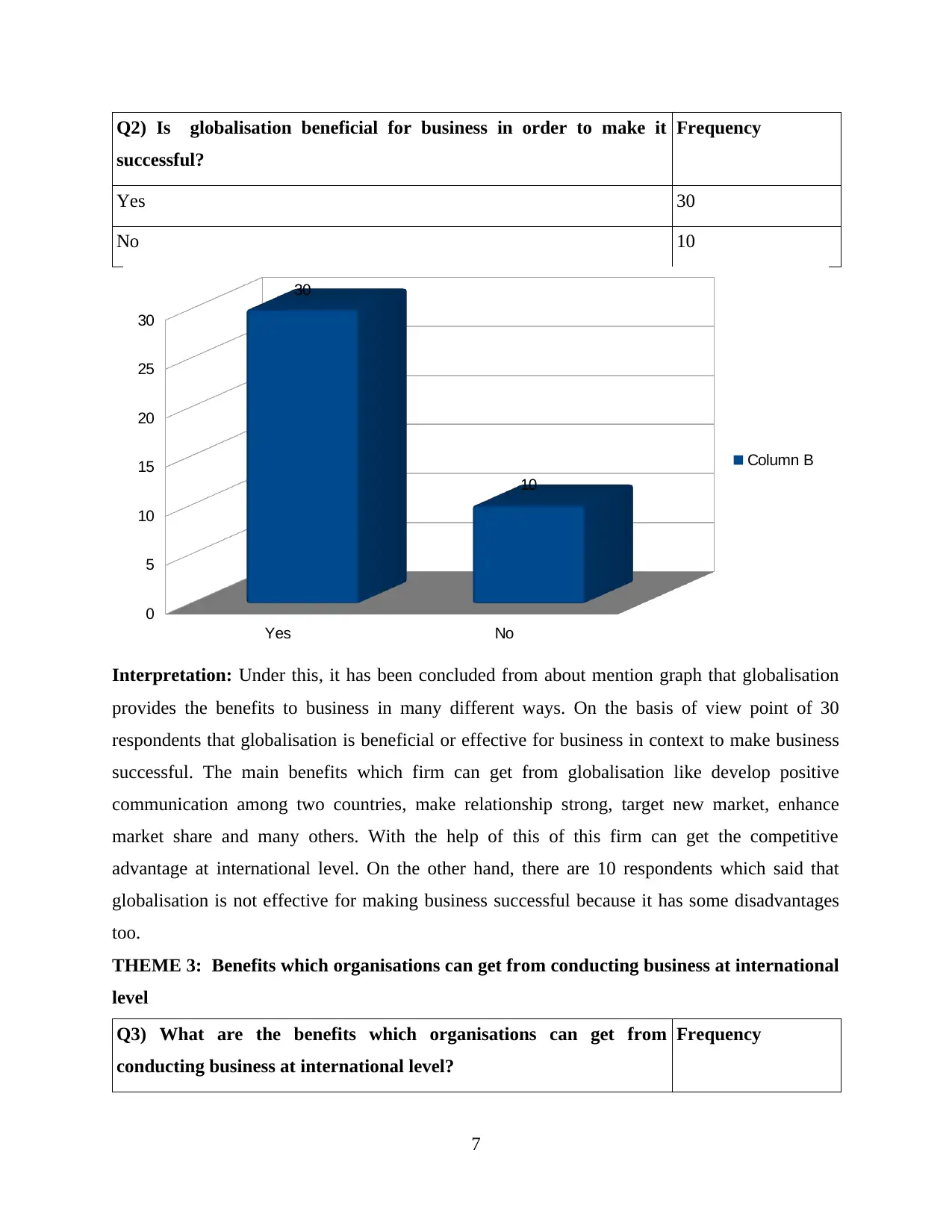
Q2) Is globalisation beneficial for business in order to make it
successful?
Frequency
Yes 30
No 10
Interpretation: Under this, it has been concluded from about mention graph that globalisation
provides the benefits to business in many different ways. On the basis of view point of 30
respondents that globalisation is beneficial or effective for business in context to make business
successful. The main benefits which firm can get from globalisation like develop positive
communication among two countries, make relationship strong, target new market, enhance
market share and many others. With the help of this of this firm can get the competitive
advantage at international level. On the other hand, there are 10 respondents which said that
globalisation is not effective for making business successful because it has some disadvantages
too.
THEME 3: Benefits which organisations can get from conducting business at international
level
Q3) What are the benefits which organisations can get from
conducting business at international level?
Frequency
7
Yes No
0
5
10
15
20
25
30
30
10
Column B
successful?
Frequency
Yes 30
No 10
Interpretation: Under this, it has been concluded from about mention graph that globalisation
provides the benefits to business in many different ways. On the basis of view point of 30
respondents that globalisation is beneficial or effective for business in context to make business
successful. The main benefits which firm can get from globalisation like develop positive
communication among two countries, make relationship strong, target new market, enhance
market share and many others. With the help of this of this firm can get the competitive
advantage at international level. On the other hand, there are 10 respondents which said that
globalisation is not effective for making business successful because it has some disadvantages
too.
THEME 3: Benefits which organisations can get from conducting business at international
level
Q3) What are the benefits which organisations can get from
conducting business at international level?
Frequency
7
Yes No
0
5
10
15
20
25
30
30
10
Column B
Paraphrase This Document
Need a fresh take? Get an instant paraphrase of this document with our AI Paraphraser
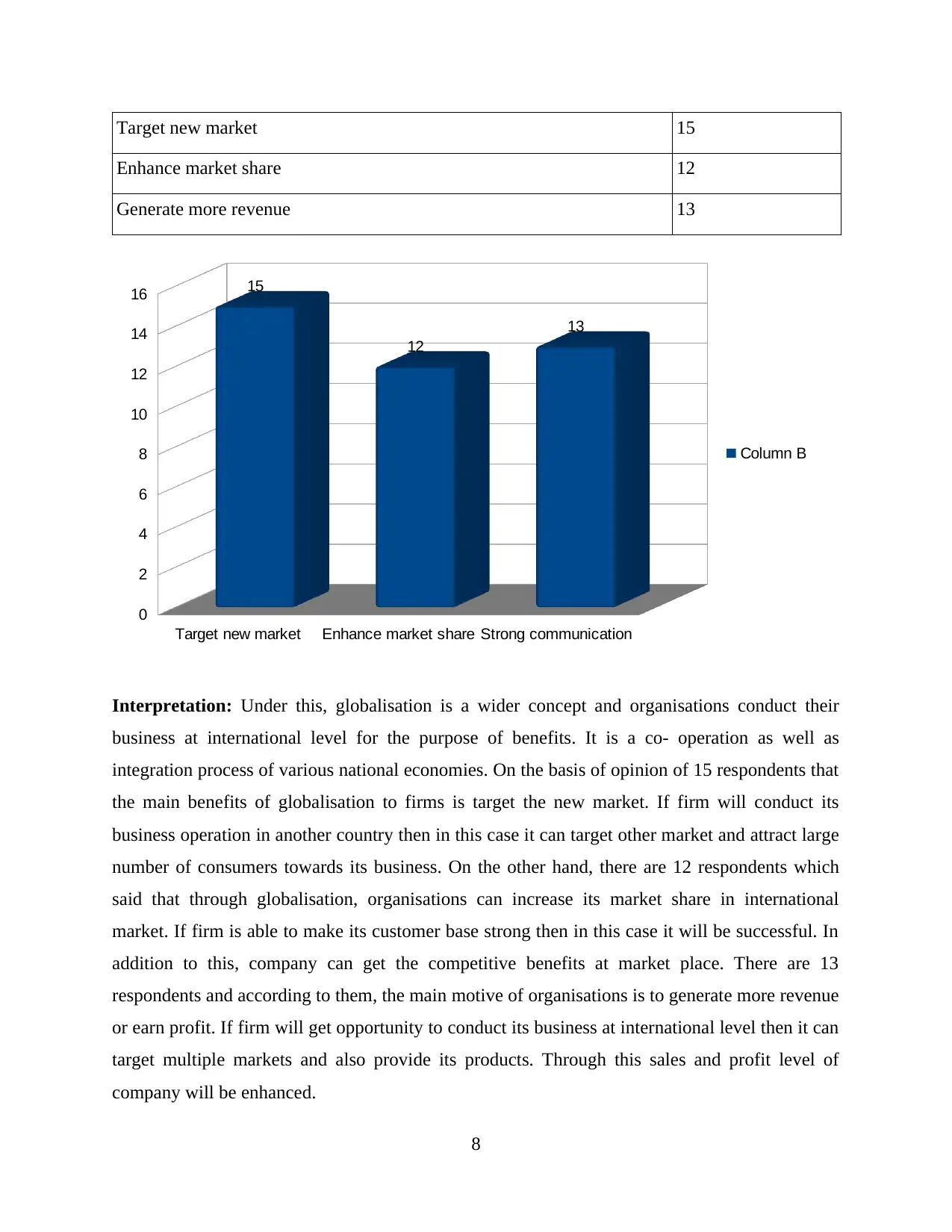
Target new market 15
Enhance market share 12
Generate more revenue 13
Interpretation: Under this, globalisation is a wider concept and organisations conduct their
business at international level for the purpose of benefits. It is a co- operation as well as
integration process of various national economies. On the basis of opinion of 15 respondents that
the main benefits of globalisation to firms is target the new market. If firm will conduct its
business operation in another country then in this case it can target other market and attract large
number of consumers towards its business. On the other hand, there are 12 respondents which
said that through globalisation, organisations can increase its market share in international
market. If firm is able to make its customer base strong then in this case it will be successful. In
addition to this, company can get the competitive benefits at market place. There are 13
respondents and according to them, the main motive of organisations is to generate more revenue
or earn profit. If firm will get opportunity to conduct its business at international level then it can
target multiple markets and also provide its products. Through this sales and profit level of
company will be enhanced.
8
Target new market Enhance market share Strong communication
0
2
4
6
8
10
12
14
16 15
12
13
Column B
Enhance market share 12
Generate more revenue 13
Interpretation: Under this, globalisation is a wider concept and organisations conduct their
business at international level for the purpose of benefits. It is a co- operation as well as
integration process of various national economies. On the basis of opinion of 15 respondents that
the main benefits of globalisation to firms is target the new market. If firm will conduct its
business operation in another country then in this case it can target other market and attract large
number of consumers towards its business. On the other hand, there are 12 respondents which
said that through globalisation, organisations can increase its market share in international
market. If firm is able to make its customer base strong then in this case it will be successful. In
addition to this, company can get the competitive benefits at market place. There are 13
respondents and according to them, the main motive of organisations is to generate more revenue
or earn profit. If firm will get opportunity to conduct its business at international level then it can
target multiple markets and also provide its products. Through this sales and profit level of
company will be enhanced.
8
Target new market Enhance market share Strong communication
0
2
4
6
8
10
12
14
16 15
12
13
Column B
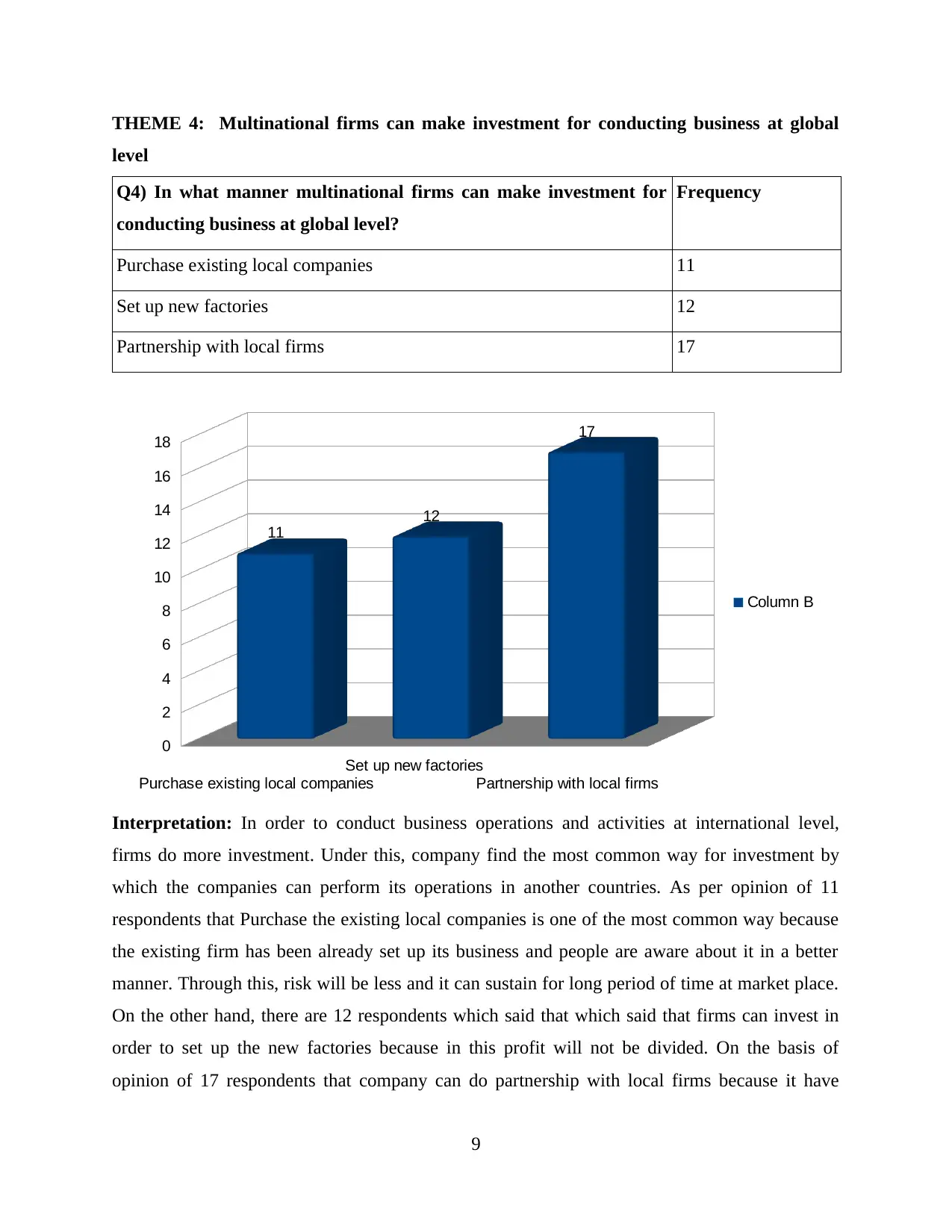
THEME 4: Multinational firms can make investment for conducting business at global
level
Q4) In what manner multinational firms can make investment for
conducting business at global level?
Frequency
Purchase existing local companies 11
Set up new factories 12
Partnership with local firms 17
Interpretation: In order to conduct business operations and activities at international level,
firms do more investment. Under this, company find the most common way for investment by
which the companies can perform its operations in another countries. As per opinion of 11
respondents that Purchase the existing local companies is one of the most common way because
the existing firm has been already set up its business and people are aware about it in a better
manner. Through this, risk will be less and it can sustain for long period of time at market place.
On the other hand, there are 12 respondents which said that which said that firms can invest in
order to set up the new factories because in this profit will not be divided. On the basis of
opinion of 17 respondents that company can do partnership with local firms because it have
9
Purchase existing local companies
Set up new factories
Partnership with local firms
0
2
4
6
8
10
12
14
16
18
11
12
17
Column B
level
Q4) In what manner multinational firms can make investment for
conducting business at global level?
Frequency
Purchase existing local companies 11
Set up new factories 12
Partnership with local firms 17
Interpretation: In order to conduct business operations and activities at international level,
firms do more investment. Under this, company find the most common way for investment by
which the companies can perform its operations in another countries. As per opinion of 11
respondents that Purchase the existing local companies is one of the most common way because
the existing firm has been already set up its business and people are aware about it in a better
manner. Through this, risk will be less and it can sustain for long period of time at market place.
On the other hand, there are 12 respondents which said that which said that firms can invest in
order to set up the new factories because in this profit will not be divided. On the basis of
opinion of 17 respondents that company can do partnership with local firms because it have
9
Purchase existing local companies
Set up new factories
Partnership with local firms
0
2
4
6
8
10
12
14
16
18
11
12
17
Column B
⊘ This is a preview!⊘
Do you want full access?
Subscribe today to unlock all pages.

Trusted by 1+ million students worldwide
1 out of 24
Related Documents
Your All-in-One AI-Powered Toolkit for Academic Success.
+13062052269
info@desklib.com
Available 24*7 on WhatsApp / Email
![[object Object]](/_next/static/media/star-bottom.7253800d.svg)
Unlock your academic potential
Copyright © 2020–2025 A2Z Services. All Rights Reserved. Developed and managed by ZUCOL.





